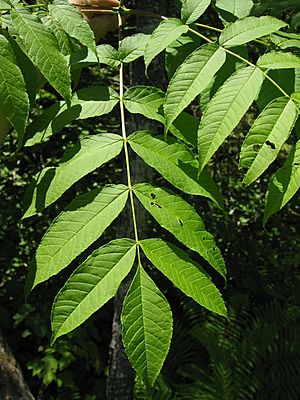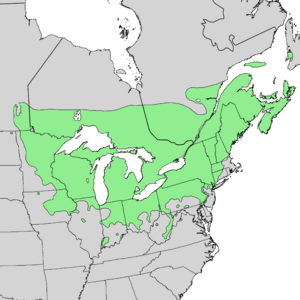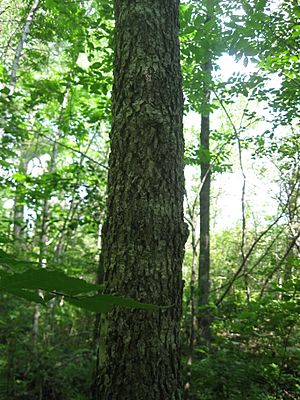Black ash facts for kids
Quick facts for kids Black ash |
|
|---|---|
 |
|
| Conservation status | |
| Scientific classification | |
| Genus: |
Fraxinus
|
| Species: |
nigra
|
 |
|
| Natural range | |
The black ash (scientific name: Fraxinus nigra) is a type of ash tree. It grows naturally across a large part of eastern Canada and the northeastern United States. You can find it from western Newfoundland all the way west to southeastern Manitoba. It also grows south into Illinois and northern Virginia.
This tree used to be very common. However, since 2014, the black ash is in danger of almost disappearing. This is because of a tiny bug called the emerald ash borer. This insect is destroying ash trees across their habitat.
Contents
What is a Black Ash Tree?
The black ash is a medium-sized deciduous tree. This means it loses its leaves every fall. It usually grows to be about 15 to 20 meters (around 50 to 65 feet) tall. Some can even reach 26 meters (about 85 feet). Its trunk can be up to 60 centimeters (24 inches) wide. Very old trees can have trunks as wide as 160 centimeters (63 inches).
The tree's bark is grey and thick. Even young trees have corky bark. As the tree gets older, the bark becomes scaly and cracked. The buds in winter are dark brown or black. They feel soft and velvety.
Leaves, Flowers, and Fruit
Black ash leaves grow in pairs on opposite sides of the branch. Each leaf is made up of 7 to 13 smaller leaflets. Most often, there are 9 leaflets. A whole leaf can be 20 to 45 centimeters (8 to 18 inches) long. Each leaflet is 7 to 16 centimeters (3 to 6 inches) long and 2.5 to 5 centimeters (1 to 2 inches) wide. They have tiny teeth along their edges. The leaflets attach directly to the main leaf stem without a small stalk.
The flowers appear in spring, just before the new leaves grow. They are small and don't have petals. They grow in loose clusters and are pollinated by the wind. The fruit is a samara. This is a special type of winged seed. Each samara is 2.5 to 4.5 centimeters (1 to 1.8 inches) long. It has a single seed about 2 centimeters (0.8 inches) long. The wing helps the seed fly away in the wind.
Black Ash in Nature
Black ash trees often grow in swamps. They are often found with green ash trees. In the fall, their leaves turn yellow. Black ash trees are one of the first trees to lose their leaves each autumn.
The black ash is very similar to the Manchurian ash. These two types of ash trees can easily mix and create new kinds of ash. Some scientists think they are just different versions of the same tree, growing in different places.
The Threat of the Emerald Ash Borer
Before 2002, black ash trees were very common. No one worried about them disappearing. But then, the emerald ash borer arrived in North America. This tiny, shiny green beetle is an invasive species. This means it's not from here and causes harm.
Since 2002, the emerald ash borer has spread across most of the black ash's home range. Within a few years, almost all black ash trees are expected to die. Green ash trees face a similar problem. Other ash trees like blue ash and white ash are also in danger, but maybe a little less.
How People Use Black Ash
Native American people in the North East have used black ash wood for a long time. They make beautiful baskets and other tools from it. The Shakers, a religious group, also used black ash to make many baskets. This is why the tree is sometimes called "basket ash." Other names include brown ash, swamp ash, hoop ash, and water ash.
Black ash wood is also popular for making electric guitars and basses. People like it because it has good sound qualities.
Making Basket Strips
Black ash is special because its growth rings are not strongly connected. This makes it perfect for basket makers. To get strips, people hit the wood with a mallet. This crushes the softer spring wood layer. Then, the tougher, darker summer wood layer can be peeled off in long strips.
These long strips are then cleaned and trimmed. They are used to weave baskets. Indigenous peoples of the Northeastern Woodlands also make bark baskets from black ash. These were traditionally used for gathering berries.
Black Ash and Wildlife
North American ash trees are very important for frogs. The leaves that fall from ash trees are a key food source for tadpoles. Tadpoles eat these leaves in ponds, puddles, and other water sources.
Trees like red maple are now growing where ash trees used to be. But maple leaves are not as good for tadpoles to eat. This means fewer frogs survive, and they don't grow as big. Ash trees native to North America have low levels of chemicals called tannins. This makes their leaves good for frogs. But it also means the trees can't fight off the emerald ash borer very well. Ash trees from other parts of the world usually have higher tannin levels. This helps them resist the borer.
North American ash trees also provide homes and food for many other animals. These include long-horned beetles, birds, and mammals. Many types of Lepidoptera (butterflies and moths) also lay their eggs on ash trees. Their larvae (caterpillars) then eat the leaves.




